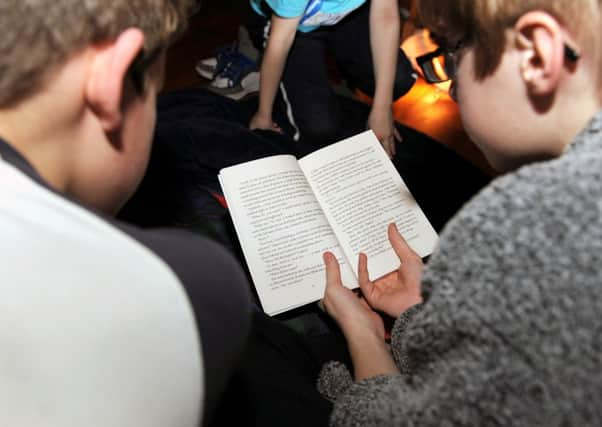Falkirk school leavers head for ‘positive destinations’ as district’s results look good


The newly published figures for 2017/18 highlight that attainment has risen across the board – placing Falkirk firmly in the top quartile of all local authorities in Scotland.
In particular there are two stand-out areas, members of Falkirk Council education executive heard this week.
Advertisement
Hide AdAdvertisement
Hide AdThe area’s highest achievers have done better than ever before – but so have those from the most deprived areas,
Education head David Mackay was delighted with the results from the lowest achieving children.
He said: “The improvement is quite remarkable this year – it is the equivalent to every child getting an additional five passes at National 5!”
That’s very welcome news for the politicians for whom closing the poverty related attainment gap is a priority that has proved difficult to tackle.
Meanwhile, the highest achieving children’s results improved by the equivalent of an extra Higher and National 5 pass each.
“It shows we have got the strategy right going forward,” said council leader Cecil Meiklejohn.
“The highest achieving children are going further and those at the bottom have significantly shifted.”
“There is no single reason for this improvement,” said Mr Mackay. “These results have been steadily improving for some time and are a result of many factors working together.”
Advertisement
Hide AdAdvertisement
Hide AdWhile the headlines were grabbed recently by schools whose pupils achieved five Highers or more, the council’s statistics look at a much more complex picture, where passing Highers is not the only way for pupils to succeed.
They are able to compare their performance to other council areas by using four measures that form a ‘virtual comparator’ which allows them to build a meaningful picture over time.
This ensures they are actually comparing pupils of the same gender, social deprivation, additional support needs and how old they were when they left school – all of which are important factors in attainment.
However, it wasn’t just the results that made for good reading.
Councillor Meiklejohn also warmly welcomed the news that 95 per cent of pupils achieve a ‘positive destination’ – leaving school to continue education or start training or work.
That figure is slightly above the national average and compares well to neighbouring authorities, Stirling, Clackmannan and West Lothian.
In 2017/18, 1543 young people left Falkirk Council’s secondary schools – 136 at the end of S4, 415 in S5 and 992 in S6.
Compared to the previous year, a higher percentage of the cohort went into further and higher education.
Advertisement
Hide AdAdvertisement
Hide AdCouncillor McCue said: “This shows how much tremendous work is going on in our schools.
“We are actually able to tailor what is being offered to suit children’s needs, which is fantastic!”
In particular, Mrs Meiklejohn praised the partnership between local schools and Forth Valley College.
“I think this result is testament to the work schools have been doing with the college, not just through Foundation Apprenticeships, but also many different opportunities,” said Mrs Meiklejohn.
“They have been working hard to break down the barriers for pupils who previously would not have considered going to university or college.”
At the meeting, Councillor Pat Reid welcomed the news but pointed out that the information was ‘just a snapshot’.
He asked if there was any information about what happens next for young people.
“We know that young people get apprenticeships, but do they all lead to jobs?” he asked. “We know they go to university but do they drop out?”
Advertisement
Hide AdAdvertisement
Hide Ad“That’s an important point and the information is not easy to get,” said Mr McKay.
“However, we are trying to build up a better picture so we can be sure our young people are finding the right pathway for them,”
The attainment figures also showed encouraging improvement for attainment in literacy and numeracy – key skills for young people looking for employment.
They showed 86 per cent of school leavers left with level 5 literacy (roughly equivalent to a National 5) which is not only above the national average but also an increase from 69 per cent in 2013/14.
While the numeracy results were less convincing – 77 per cent achieving level 5 - that was well up on the 2013/14 figure of just 61 per cent.
Those results place Falkirk comfortably in the top quartile of local authorities in Scotland for both literacy and numeracy.
“We do not rest on our laurels,” promised Mrs Meiklejohn.
“We have always been good, but we’ve felt that wasn’t good enough.
“But we are on the right track to help our young people be the best that they can be.”
Advertisement
Hide AdAdvertisement
Hide AdCouncillor McCue believes government initiatives to give headteachers more control over spending are beginning to pay off.
“They are able to look at their community and look at specific needs for their young people,” she said.
The hope now is that the Pupil Equity Fund will begin to have an affect as children who have benefited from it head to secondary school.
Longer term, the massive expansion of early years education currently underway should bring a boost.
“It’s an exciting time in education,” said Ms McCue.